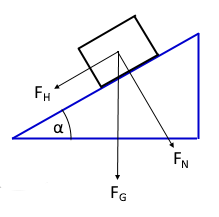Calculate Inclined Plane
Calculator and formulas for calculating an inclined plane
Inclined Plane Calculator
Force decomposition on inclined plane
Calculates the force components on an inclined plane: Weight force (FG), Downhill force (FH) and Normal force (FN).

Example Calculation
Example: Box on inclined plane
Problem:
A box with 50 kg mass lies on an inclined plane with 30° inclination. Calculate all force components (g = 9.81 m/s²).
Given:
- Mass m = 50 kg
- Inclination angle α = 30°
- g = 9.81 m/s²
- FG = m × g = 50 × 9.81 = 490.5 N
Solution:
Practical Applications
Important Angle Values
- 0°: sin = 0, cos = 1
- 30°: sin = 0.5, cos = 0.866
- 45°: sin = 0.707, cos = 0.707
- 60°: sin = 0.866, cos = 0.5
- 90°: sin = 1, cos = 0
- Gradient 1:3 ≈ 18.4°
|
|
Formulas for inclined plane
On an inclined plane the weight force is decomposed into two components: the downhill force (parallel to the plane) and the normal force (perpendicular to the plane).
Downhill force FH
Force component parallel to the inclined plane (sliding force).
Normal force FN
Force component perpendicular to the inclined plane.
Weight force FG
Resultant from both components.
Important Notes
- At α = 0°: FH = 0 and FN = FG (horizontal plane)
- At α = 90°: FH = FG and FN = 0 (vertical fall)
- The downhill force increases with increasing inclination angle
- The normal force decreases with increasing inclination angle
Detailed description of the inclined plane
Physical Fundamentals
This function calculates the forces acting on an inclined plane. The weight force FG can be divided into a component perpendicular to the inclined plane (normal force component FN) and a component parallel to the inclined plane (downhill force FH).
Usage Instructions
Enter a known force (FG, FH or FN) and the inclination angle. The calculator automatically calculates all other force components.
Application Areas
Road and Path Construction
Calculation of downhill forces for vehicles on inclined roads. Important for braking distances and traction.
Mechanical Engineering
Conveyor belts, slides, ramps, inclined conveyor systems. Dimensioning of drives and braking systems.
Construction
Roof structures, stairs, slopes, slip safety. Static calculations for inclined components.
Understanding Force Decomposition
Force decomposition on the inclined plane is a fundamental concept in mechanics. The steeper the plane, the greater the downhill force becomes:
Flat plane (15°)
FH = FG × sin(15°) ≈ 0.26 × FG
FN = FG × cos(15°) ≈ 0.97 × FG
Medium inclination (45°)
FH = FG × sin(45°) ≈ 0.71 × FG
FN = FG × cos(45°) ≈ 0.71 × FG
Steep plane (75°)
FH = FG × sin(75°) ≈ 0.97 × FG
FN = FG × cos(75°) ≈ 0.26 × FG
Insight: The steeper the plane, the greater the downhill force and the smaller the normal force!
|
|
|
|